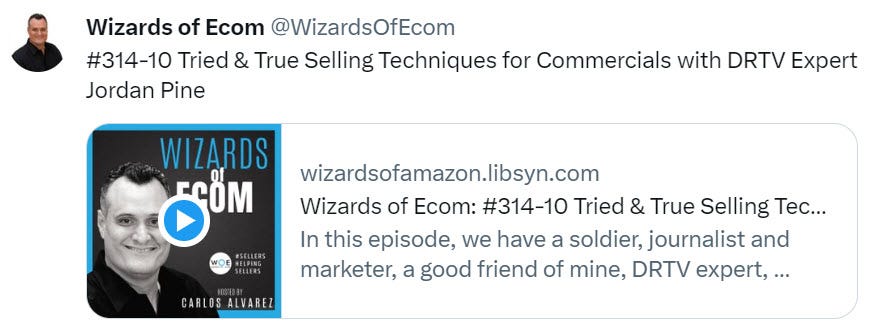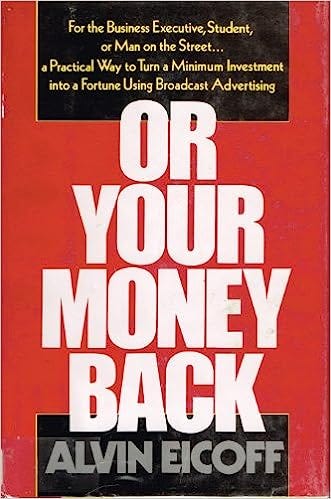Pitch Perfect: How to Create Commercials That Create Sales
Nine guidelines for TV commercials from the father of DRTV
Last month, I was delighted to be invited onto the Wizards of Ecom podcast for an interview. It was a special thrill for me because the host, Carlos Alvarez, has been our guru and guide this year as we have tried to learn everything possible about selling on Amazon. The episode dropped Monday, and you can listen to it by clicking the image below. Our conversation is about my list of tried-and-true techniques for commercials.
Speaking of T&T for DRTV, this week I thought it would be appropriate to go back and hear from the creator of the original technique: Alvin Eicoff.
I’ve mentioned Eicoff before. He’s another “founding father” of direct marketing. Specifically, he’s the founder of my particular discipline: direct-response television (DRTV) advertising. Eicoff started the first DRTV agency in 1959, A. Eicoff & Company, and pioneered the use of two-minute commercials with 1-800 numbers. He also coined the phrase, “or your money back,” which is the title of his 1983 marketing guide and autobiography.
In my article, The 10 Greatest Marketing Concepts in One Sentence Each, Eicoff’s “pitchman technique” is #5. I didn’t have the space to elaborate on the concept, so let’s fix that today and take a closer look.
“Pitchmen created the perfect sales pitch and, eventually, the perfect commercial.”
Before we get to our main topic, a word about terms. Last week, I started the newsletter with a bunch of similar phrases for marketing disciplines that many, myself included, have found confusing. Going all the way back to Lester Wunderman as my authority, I declared “direct marketing” to be the one term to rule them all. But what about the term “direct response” (DR), which many of us in the DRTV world prefer? Is that the same thing? Should it still be used?
In the glossary of his book, Eicoff provides an answer to that question (emphasis mine):
“DIRECT MARKETING: The sale of product or service by the advertisers directly to consumer without use of a retail outlet (what the seller does)”
“DIRECT RESPONSE: The direct ordering of product or service by mail or phone without use of a retail out (what the buyer does)”
Leave it to a Master: That’s the easiest way to differentiate those terms I’ve found. Direct marketing is what we (the sellers) do. Direct response is what they (the buyers) do. Resolved!
Now, here are the specifics of Eicoff’s “pitchman technique” from chapter 11 of his book.
“The essence of the approach is to set forth the problem, explain the solution, and then demonstrate why a specific product best meets that solution.”
How to Create Commercials That Create Sales
by Alvin Eicoff
Make your commercial simple and straightforward. “The shortest distance between two points is a straight line. Similarly, the shortest distance between seller and buyer is a straightforward presentation.”
Begin with the problem and how your product solves that problem. “Too many copywriters don’t understand that when they write a commercial they are knocking on someone’s door and asking to come into their living room. If they would use this frame of reference, they wouldn’t come into the living room with animated beavers, chorus lines, or semipornographic models.” 😂
Use video and audio to connect with the consumer. “The potential customer should feel a strong personal identification with the problem presented, reflexively nodding his head in acknowledgement … [Certain] words (e.g. ‘bending, stooping and straining’) have an almost visceral kick to them…once they’re uttered, the viewer immediately thinks, ‘That’s me.’”
Demonstrate the product’s most universal benefit. “Choosing the manner in which a product is demonstrated is crucial. The creative team must pinpoint the one demonstration with the most universal appeal. The more problems the demonstrations solves, the greater the chance of motivating the viewer to buy the product.”
Don’t forget to demonstrate secondary benefits. “By spelling out these secondary benefits, a product is automatically made more attractive to a wider range of viewers.”
Employ the Parallel Structure Technique (PST). “This involves placing the viewer in two identical situations: one with the product advertised and one without. This parallel structure motivates the viewer to objectively analyze his need for the product.”
Add force with verbal exclamation points. “Many advertisers have also forgotten the importance of certain words such as ‘amazing,’ ‘revolutionary,’ ‘new,’ and ‘incredible.’ They immediately trigger the viewer’s interest because they are the verbal equivalents of exclamation points, adding force to the sales presentation … Of course, these words should be used with discretion.”
Give enough information to make a buying decision. “How many times have you seen a commercial that has neglected to give essential information about a product? Information such as how it works, how much it costs, and where you can buy it. After viewing a noninformational commercial, the audience is left with many questions and no answers. Without those answers it is difficult to make a buying decision.”
Always end with a guarantee. “There is no more powerful sales tool than a money-back guarantee. It is the advertiser’s promise to put his money where his mouth is … For the viewer, treading the line between buying or not buying a product, the guarantee is the nudge he needs to cross that line and make a positive buying decision.”
I’ll finish by sharing a final quote from Eicoff’s book that eloquently captures his admiration for the pitchmen that inspired the above technique:
Once they roamed the land free and easy as you please…They had the gift of gab and could charm ten-dollar bills out of the most tightfisted of men. Their razzle-dazzle sales pitches were an art form; they would demonstrate how a product worked with flair and grace, and everyone from hicks to high-rollers would fall under their spell…
In 1950, you could still find a pitchman as a state fair or carnival or trade show, drawing a crowd with his pitch sure as a magnet draws metal.
A few years ago, we discovered a young talent in this old mold that Eicoff is describing. Check out Ronnie Neville on our new Ultimate Irish YouTube channel, and tell me he doesn’t capture that pitchman spirit!
Chart Watch👁️
Vivi Disk
Pitch: “The most versatile, portable and colorful solar-powered pathway disk lights”
Offer: $19.95 for a set of four, 2nd set for a separate fee
Brand: Bell+Howell
Marketer: Emson
This commercial first tested in June of last year and made a brief appearance on the DRMetrix report that summer. It reappeared in May of this year and has been steadily climbing. This week, it’s in the DRMetrix Top 20.
Emson has tried a few color-changing landscape lights. Another one, Glimmer Sticks, tested around the same time last year but has not reappeared. Perhaps the form of the light makes a difference? People may not like sticks, but Emson knows they definitely like disks. Their Bell+Howell Disk Lights were on the True Top 50 in both 2018 and 2019.
For Premium Subscribers🔒
Past this point, it’s paying subscribers only. Below you will find all the usual stuff PLUS a special “Old Gold” entry featuring a list of 10 hits from Eicoff’s heyday that might just stimulate some new ideas!






